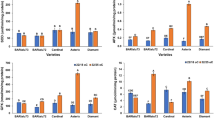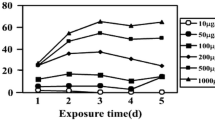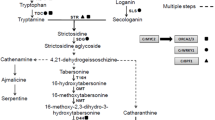Abstract
To study the photochemical responses of photosystem II (PSII) and mitochondrial alternative oxidase (AOX) to heat stress in grapevine (Vitis vinifera L. cv. ‘Cabernet Sauvignon’), we exposed grape leaves to a range of temperatures (25, 30, 35, 40, and 42.5 °C) in the light (600 µmol m−2 s−1). At temperatures >35 °C, the rate of photosynthetic O2 evolution and the maximal photochemistry efficiency of PSII (Fv/Fm) decreased significantly. We observed that the relative variable fluorescence increased at the J step, and there was also an accumulation of H2O2. In addition, there was an increase in both the non-photochemical quenching (NPQ) and the capacity of the alternative oxidase pathway (AOX) at higher temperatures. When the leaves were treated with the AOX inhibitor salicylhydroxamic acid, a significant decrease in the PSII electron transport rate and NPQ and an increase in H2O2 content occurred. Our results suggest that high temperature limits electron transport beyond Q −A , resulting in a strong accumulation of H2O2 in grape leaves. Inhibition of the AOX pathway increases the formation and accumulation of H2O2 in grape leaves, and may thereby increase photoinhibition in leaves experiencing heat stress.









Similar content being viewed by others
Abbreviations
- AOX:
-
Alternative oxidase
- PSII:
-
Photosystem II
- ROS:
-
Reactive oxygen species
- SHAM:
-
Salicylhydroxamic acid
References
Ahn TK, Avenson TJ, Ballottari M, Cheng YC, Niyogi KK, Bassi R, Fleming GR (2008) Architecture of a charge-transfer state regulating light harvesting in a plant antenna protein. Science 320:794–797
Allakhverdiev SI, Kreslavski VD, Klimov VV, Los DA, Carpentier R, Mohanty P (2008) Heat stress: an overview of molecular responses in photosynthesis. Photosynth Res 98:541–550
Bartoli CG, Gomez F, Gergoff G, Guiamét JJ, Puntarulo S (2005) Up-regulation of the mitochondrial alternative oxidase pathway enhances photosynthetic electron transport under drought conditions. J Exp Bot 56:1269–1276
Brennan T, Frenkel C (1977) Involvement of hydrogen peroxide in the regulation of senescence in pear. Plant Physiol. 59: 411–416
Bukhov NG, Samson G, Carpentier R (2000) Nonphotosynthetic reduction of the intersystem electron transport chain of chloroplasts following heat stress. Steady-state rate. Photochem Photobiol 72:351–357
Crafts-Brandner SJ, Salvucci ME (2000) Rubisco activase constrains the photosynthetic potential of leaves at high temperature and CO2. Proc Natl Acad Sci 97:13430–13435
Gilmore AM (1997) Mechanistic aspects of xanthophyll cycle-dependent photoprotection in higher plant chloroplasts and leaves. Physiol Plant 99:197–209
Havaux M (1996) Short-term responses of photosystem I to heat stress: induction of a PSII-independent electron transport through PS I fed by stromal components. Photosynth Res 47:85–97
Jahns P, Latowski D, Strzalka K (2009) Mechanism and regulation of the violaxanthin cycle: the role of antenna proteins and membrane lipids. Biochim Biophys Acta 1787:3–14
Jiang CD, Gao HY, Zou Q (2001) Enhanced thermal energy dissipation depending on xanthophyll cycle and D1 protein turnover in iron-deficient maize leaves under high irradiance. Photosynthetica 39:269–274
Jiang CD, Jiang GM, Wang X, Li LH, Biswas DK, Li YG (2006) Increased photosynthetic activities and thermostability of photosystem II with leaf development of elm seedlings (Ulmus pumila) probed by the fast fluorescence rise OJIP. Environ Exp Bot 58:261–268
Ledford HK, Niyogi KK (2005) Singlet oxygen and photo-oxidative stress management in plants and algae. Plant Cell Environ 28:1037–1045
Mathur S, Jajoo A, Mehta P, Bharti S (2011) Analysis of elevated temperature-induced inhibition of photosystem II using chlorophyll a fluorescence induction kinetics in wheat leaves (Triticum aestivum). Plant Biol 13:1–6
Murata N, Takahashi S, Nishiyama Y, Allakhverdiev SI (2007) Photoinhibition of photosystem II under environmental stress. Biochim Biophys Acta 1767:414–421
Niyogi KK (1999) Photoprotection revisited: genetic and molecular approaches. Annu Rev Plant Biol 50:333–359
Noguchi K, Yoshida K (2008) Interaction between photosynthesis and respiration in illuminated leaves. Mitochondrion 8:87–99
Ort DR, Baker NR (2002) A photoprotective role for O2 as an alternative electron sink in photosynthesis? Curr Opin Plant Biol 5:193–198
Strasser BJ (1997) Donor side capacity of photosystem II probed by chlorophyll a fluorescence transients. Photosynth Res 52:147–155
Strasser RJ, Srivastava A (1995) Polyphasic chlorophyll a fluorescence transient in plants and cyanobacteria. Photochem Photobiol 61:32–42
Strasser BJ, Strasser RJ (1995) Measuring fast fluorescence transients to address environmental questions: the JIP test. In: Mathis P (ed) Photosynthesis: from light to biosphere. Kluwer Academic Publishers, Dordrecht, pp 977–980
Takahashi S, Badger MR (2011) Photoprotection in plants: a new light on photosystem II damage. Trends Plant Sci 16:53–60
Takahashi S, Murata N (2008) How do environmental stresses accelerate photoinhibition? Trends Plant Sci 13:178–182
Thordal-Christensen H, Zhang Z, Wei Y, Collinge DB (1997) Subcellular localization of H2O2 in plants. H2O2 accumulation in papillae and hypersensitive response during the barley-powdery mildew interaction. Plant J 11:1187–1194
Tóth SZ, Schansker G, Garab G, Strasser RJ (2007) Photosynthetic electron transport activity in heat-treated barley leaves: the role of internal alternative electron donors to photosystem II. Biochim Biophys Acta 1767:295–305
Xu CC, Li L, Kuang T (2000) The inhibited xanthophyll cycle is responsible for the increase in sensitivity to low temperature photoinhibition in rice leaves fed with glutathione. Photosynth Res 65:107–114
Yang X, Wen X, Gong H, Lu Q, Yang Z, Tang Y, Liang Z, Lu C (2007) Genetic engineering of the biosynthesis of glycinebetaine enhances thermotolerance of photosystem II in tobacco plants. Planta 225:719–733
Yin Y, Li S, Liao W, Lu Q, Wen X, Lu C (2010) Photosystem II photochemistry, photoinhibition, and the xanthophyll cycle in heat-stressed rice leaves. J Plant Physiol 167:959–966
Yoshida K, Terashima I, Noguchi K (2007) Up-regulation of mitochondrial alternative oxidase concomitant with chloroplast over-reduction by excess light. Plant Cell Environ 48(4):606–614
Zhang L, Liu J (2015) Effects of heat stress on photosynthetic electron transport in a marine cyanobacterium Arthrospira sp. J Appl Phycol 28:1–7
Zhang LT, Zhang ZS, Gao HY, Xue ZC, Yang C, Meng XL, Meng QW (2011) Mitochondrial alternative oxidase pathway protects plants against photoinhibition by alleviating inhibition of the repair of photodamaged PSII through preventing formation of reactive oxygen species in Rumex K-1 leaves. Physiol Plant 143:396–407
Zhang LT, Zhang ZS, Gao HY, Meng XL, Yang C, Liu JG, Meng QW (2012) The mitochondrial alternative oxidase pathway protects the photosynthetic apparatus against photodamage in Rumex K-1 leaves. BMC Plant Biol 12:40
Zhao C, Wang X, Wang X, Wu K, Li P, Chang N, Wang J, Wang F, Li J, Bi Y (2015) Glucose-6-phosphate dehydrogenase and alternative oxidase are involved in the cross tolerance of highland barley to salt stress and UV-B radiation. J Plant Physiol 181:83–95
Acknowledgments
This work was supported by the China Agriculture Research System (CARS-30) and the Program for Yangtze River Scholars and Innovative Research Team in University (PCSIRT1155).
Author information
Authors and Affiliations
Corresponding author
Additional information
Communicated by U. Feller.
Rights and permissions
About this article
Cite this article
Sun, Y., Liu, X., Zhai, H. et al. Responses of photosystem II photochemistry and the alternative oxidase pathway to heat stress in grape leaves. Acta Physiol Plant 38, 232 (2016). https://doi.org/10.1007/s11738-016-2235-2
Received:
Revised:
Accepted:
Published:
DOI: https://doi.org/10.1007/s11738-016-2235-2




